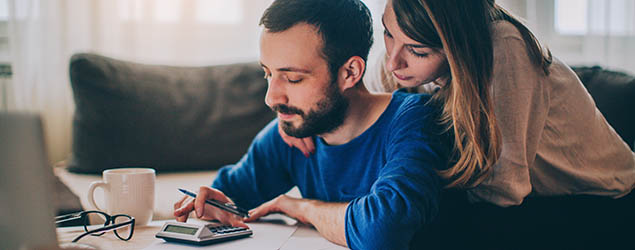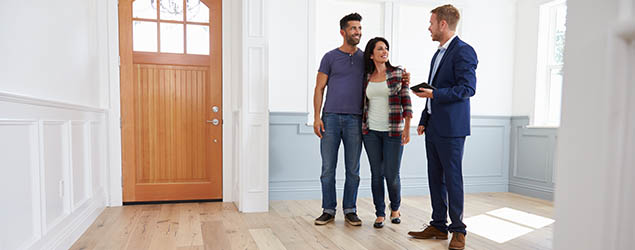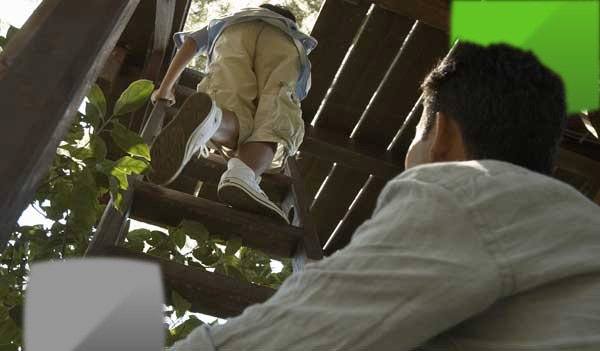Reading time 5 minutes
At a glance:
Getting a mortgage can seem complicated.
There’s lot of stages, some sums to work out and plenty of jargon to get your head around.
Find out how a mortgage can work for a first time buyer, step by step.
1
What are your finances like?
Before you start house hunting, you will want to have a look at your finances. Look at:
What savings do I have?
What debts am I paying off?
What is my credit rating like?
It can be a good idea to check your credit score. This gives you an idea about your credit history:
If you’ve missed bill payments or defaulted on a loan, for example, this can hurt your credit history.
Keeping up to date with bills and paying off a phone contract can help your score improve.
Lenders want to know that you can pay back a mortgage, before they offer you one.
It’s also a good idea to get on the electoral register for your current address. This helps lenders check who you are.
It’s also a good idea to get on the electoral register for your current address. This helps lenders check who you are.

2
What can you afford?
When you have a better idea of your finances, it’s a good idea to look at what price property you can afford.
You will need to pay for:
The deposit.
Conveyancing costs.
Valuation.
Survey.
You will also need to know what monthly repayments you can afford. Using a mortgage calculator could help you to see what your monthly repayment could be like.
3
House hunting
When choosing where to live, try making a list of what is important to you:
How many bedrooms do you need?
What’s the parking situation?
Do you need a garden?
Is there a good local school?
Is there a doctor and dentist nearby?
You can find houses using local estate agents or online, using websites like Rightmove and Zoopla.

4
Finding and applying for a mortgage
Know your loan to value ratio
Before you start looking for a mortgage deal, you will need to know your loan to value ratio. This is determined by how big your deposit is and the value of the home you want to buy.Once your know this, you can use it to see which mortgage deals may be available to you.
Interest rates
The interest rate is a key way of comparing mortgages. A higher interest rate could mean that your monthly repayment costs more. You can also use APRC to compare mortgages. This is a rate that includes any fees or changes too.You can pick between a fixed or variable interest rate:
A fixed rate is one that stays the same for a set period of time (like two, five or ten years).
A variable rate mortgage can go up or down.
Applying for a mortgage
There are 2 parts to the application:
Decision in Principle.
Full application.
Decision in Principle (DIP)
The Decision in Principle (DIP) shows that your lender may be willing to lend to you. You will need to tell them your deposit, outgoings, the price of the home you want to buy and it can involve a soft credit check.When you have a DIP and had an offer accepted, you can hire a conveyancer. A conveyancer will look after the legal parts of buying a home. You will need one to buy a home.
Full mortgage application
Next, you’ll submit your full mortgage application. You’ll need to give your lender information about your finances and the home you want to buy. Your lender will check your credit history at this stage to see if it can lend to you.Surveys and valuations
A mortgage valuation will be done by your lender. This is to make sure that the home is worth what you plan to pay for it.A survey will look at the property to makes there are no nasty surprises or extra costs after you move in. This is optional but it’s a good idea to make sure there’s no issues.

5
Final stages and moving in
If your mortgage application is successful, there’s a few more stages left before you can move in.
Paying your deposit & fees
You’ll need to pay the deposit plus the legal costs and any fees. You will do this through your conveyancer.Mortgage offer
You will receive a mortgage offer from your lender. This includes a document that sets out the terms of your mortgage and offers a breakdown of all the costs involved.Exchange of contracts
Next, you sign and send back the mortgage offer. Your conveyancer will begin the exchange of contracts with the seller’s conveyancer. This is the legal process of buying a home and means you are legally bound to the purchase.Completion & moving in!
Completion is the date when the property is legally transferred to you. This when the seller is paid and you may receive the keys to the home.Moving in!
You’ve made it! Once the exchange is complete and all fees have been paid, you can move in. Try using a moving house checklist to make the big day go as smoothly as possible.The content on this page is for reference. It is not financial advice.
For help with money issues, try MoneyHelper.
For help with money issues, try MoneyHelper.



